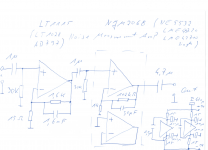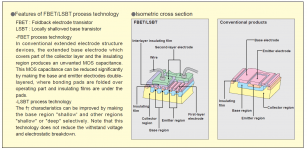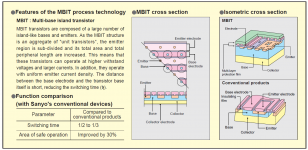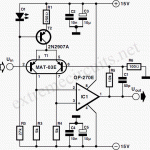I just measured the gain of my noise measuring setup :
The pre-pre is 21,27 x
The first stage is 107,67 x
The second stage is 103 x
So in total it is : 21,27 x 107,67 x 103 = 235.884,51 x
Sorry about the uneven numbers.
I used resistors that where lying around the table.
The pre-pre is 21,27 x
The first stage is 107,67 x
The second stage is 103 x
So in total it is : 21,27 x 107,67 x 103 = 235.884,51 x
Sorry about the uneven numbers.
I used resistors that where lying around the table.
The total gain in dB is around 107,5 dB.
There is a trick at the input of the pre-pre i call am hum bugger and the pre-pre has a floating supply so i do not have problems with hum.
There is a trick at the input of the pre-pre i call am hum bugger and the pre-pre has a floating supply so i do not have problems with hum.
I measured 78,43 nV with the input shorted.
With a 15 Ohm resistor at the input the noise was more.
With a 6 Ohm resistor i could not measure a diffence any more compared to the short.
The bandwidth of the measurement amp is 9 Hz - 27kHz ( -3dB ).
The square root of 26.991 is 164 so the noise is 0,478nV / qHz.
With a 15 Ohm resistor at the input the noise was more.
With a 6 Ohm resistor i could not measure a diffence any more compared to the short.
The bandwidth of the measurement amp is 9 Hz - 27kHz ( -3dB ).
The square root of 26.991 is 164 so the noise is 0,478nV / qHz.
That transfers into a noise impedance of ca. 12 Ohm.
That makes some sense because the relatively low 9Hz corner of the measurement captures also some 1/F noise.
That makes some sense because the relatively low 9Hz corner of the measurement captures also some 1/F noise.
Here is the circuit diagram of the noise measurement amp.
The first opamp is a low voltage noise part.
The second stage is less critical.
The first stage has minimal effect on the noise measurement because the Duts are in a 26dB amplifier.
When you want to build in DIL i have given alternatives.
In SMD there are more alternatives like LME 49990, OPA1611 for the first stage and even more alternatives for the second stage.
The design is completely AC coupled to avoid problems with offset and servo.
Good MKTs are fine. This is not about the sound.
The first opamp is a low voltage noise part.
The second stage is less critical.
The first stage has minimal effect on the noise measurement because the Duts are in a 26dB amplifier.
When you want to build in DIL i have given alternatives.
In SMD there are more alternatives like LME 49990, OPA1611 for the first stage and even more alternatives for the second stage.
The design is completely AC coupled to avoid problems with offset and servo.
Good MKTs are fine. This is not about the sound.
Attachments
I am a German druide from an ancient tribe.
I can manipulate gravity with the strength of my mind.
My name is Gerhard, the man with the spear.
German ( man ), Hard ( strong with the spear ).
And i build really fast when i do not have visitors......
🙂
154dB in such a big room, impressive.This is the 'high'-end 🙂 The Loudest Soundsystem In The World Will Kill You If You Hear It | Thump
But have a look at the Car audio freaks, they make small pressure chambers out of their cars and have maximum levels up to 178.1dB 😱 weird
154dB in such a big room, impressive.
But have a look at the Car audio freaks, they make small pressure chambers out of their cars and have maximum levels up to 178.1dB 😱 weird
My nephew is working as a 'strength-engineer' for the air/space industry (he did design (in a team) the leading edge of the A380) and he tells me that at 180dB (and above) (the SPL at the Ariadne rocket engine outlet) is so loud, that the structure of the rocket is at risk of falling apart. Special design features are needed to prevent the engine from destroying the rocked-engine and it's surrounding's.
Obvious there is (to me) some miscalculation/measurement when getting the 178dB, in an other YouTube video I saw someone doing a 182dB measurement while standing there with the SPL meter in hand, for sure (at 182dB) the SPL meter should have fallen apart (I think).
small pressure chambers
Long time ago, I visited the Wärtsilä (Stork at the time) marine diesel production facility in Zwolle, 80km from A'dam.
Even from the outside, the noise from the engine test/sound chamber was headache grade without ear protection.
Very interesting video. Author told that vinyl mastering and replay equipment were of good but not the highest quality. Let us imagine that record was cut at 45RPM and reproduced with 15K dollars Koetsu cartridge and top turntable and phono preamp. Will the vinyl replay be dramatically better than digital?
No, the transistors are plain old BC140, 160 made in India.
They do really well.
The Zetex are something else.
I get now some that should be even better then the ones you know Michael.
I think going under 0.3nV/qHz is possible.
With one pair and really high iddle.
Joachim, one technologie that also have low rbb are the FBET , MBIT process from Sanyo now onsemi. They are very linear.
Syn08 have measure 0.21nV/rtHz at 10mA in 2sc3601.
Attachments
Last edited:
I think that are the Sanyo RF transistors.
I have them and can compare.
They do not have a good quasi saturation range though as far as i can remember.
If that matters is dependent on the topology.
For current mirrors they are useless.
Other medium power transistor from the MJE range ( also On Semi ) are low Rbbe`too but non of them has high Hfe.
That propoerty also matters only in certain topologies.
I have them and can compare.
They do not have a good quasi saturation range though as far as i can remember.
If that matters is dependent on the topology.
For current mirrors they are useless.
Other medium power transistor from the MJE range ( also On Semi ) are low Rbbe`too but non of them has high Hfe.
That propoerty also matters only in certain topologies.
I measured the new Zetex transistors.
I read 14mV.
That transfers into 0.36nV / qHz.
That is ca 7 Ohm noise impedance.
Here an aditional 6 Ohm already worsens the noise reading.
My Lyras are around 5 Ohm so i think mission acomplished.
I will compare this ones more to last years champions.
Also Zetex SMD.
I read 14mV.
That transfers into 0.36nV / qHz.
That is ca 7 Ohm noise impedance.
Here an aditional 6 Ohm already worsens the noise reading.
My Lyras are around 5 Ohm so i think mission acomplished.
I will compare this ones more to last years champions.
Also Zetex SMD.
I measured the new Zetex transistors.
I read 14mV.
That transfers into 0.36nV / qHz.
That is ca 7 Ohm noise impedance.
Here an aditional 6 Ohm already worsens the noise reading.
My Lyras are around 5 Ohm so i think mission acomplished.
I will compare this ones more to last years champions.
Also Zetex SMD.
So, this will make an ultra-low-noise op-amp?



